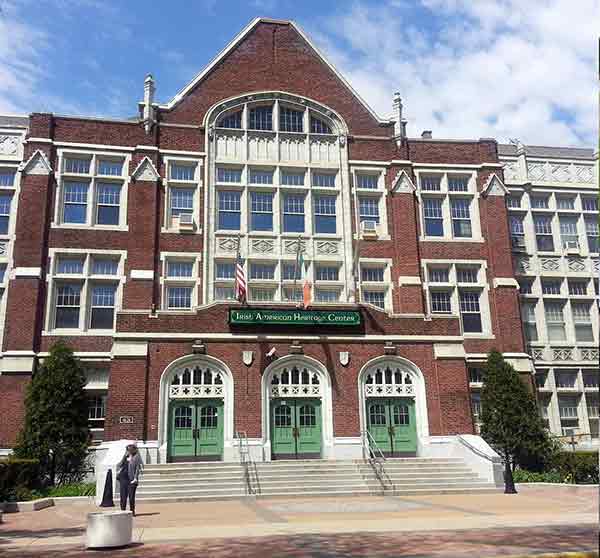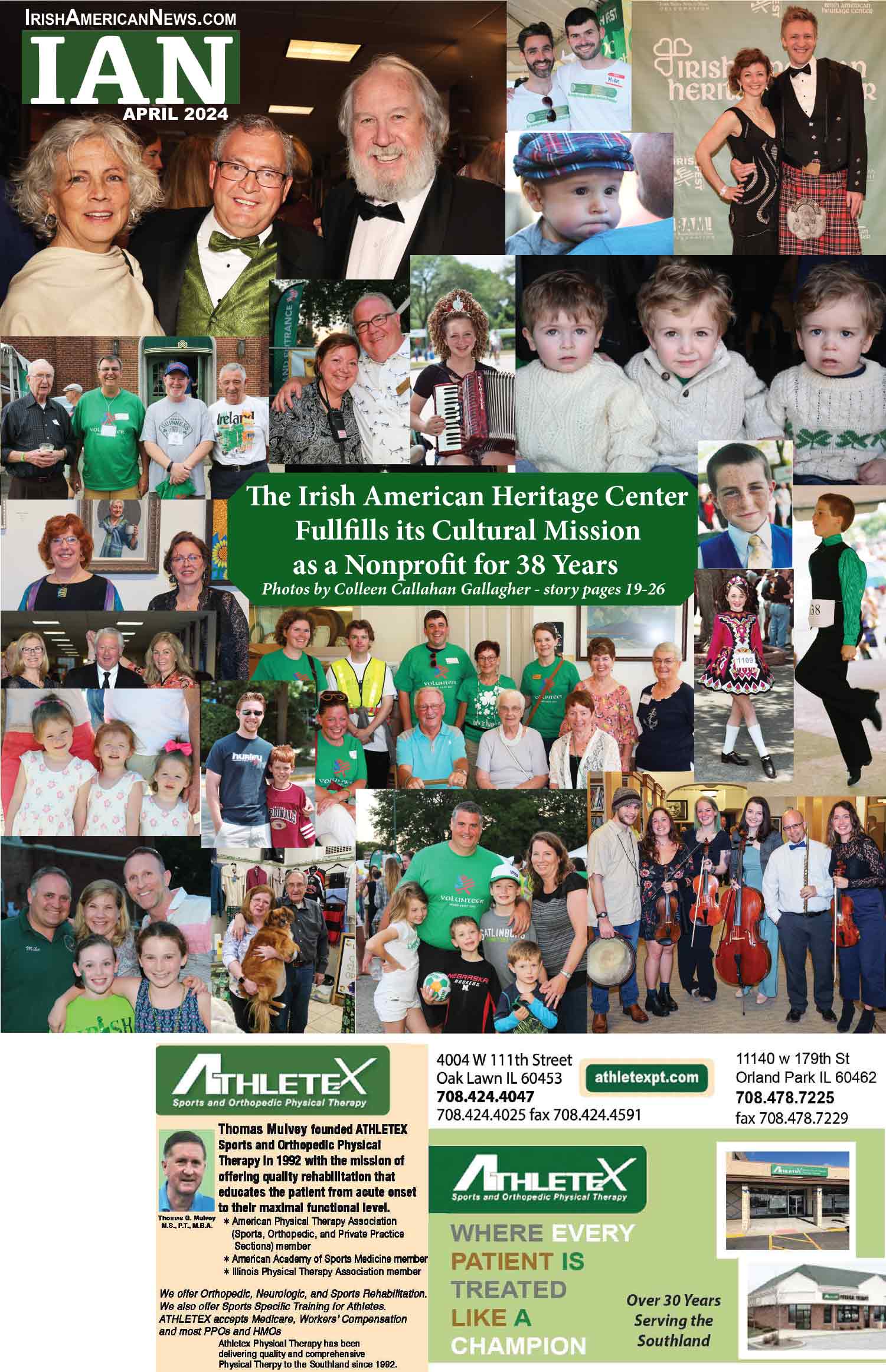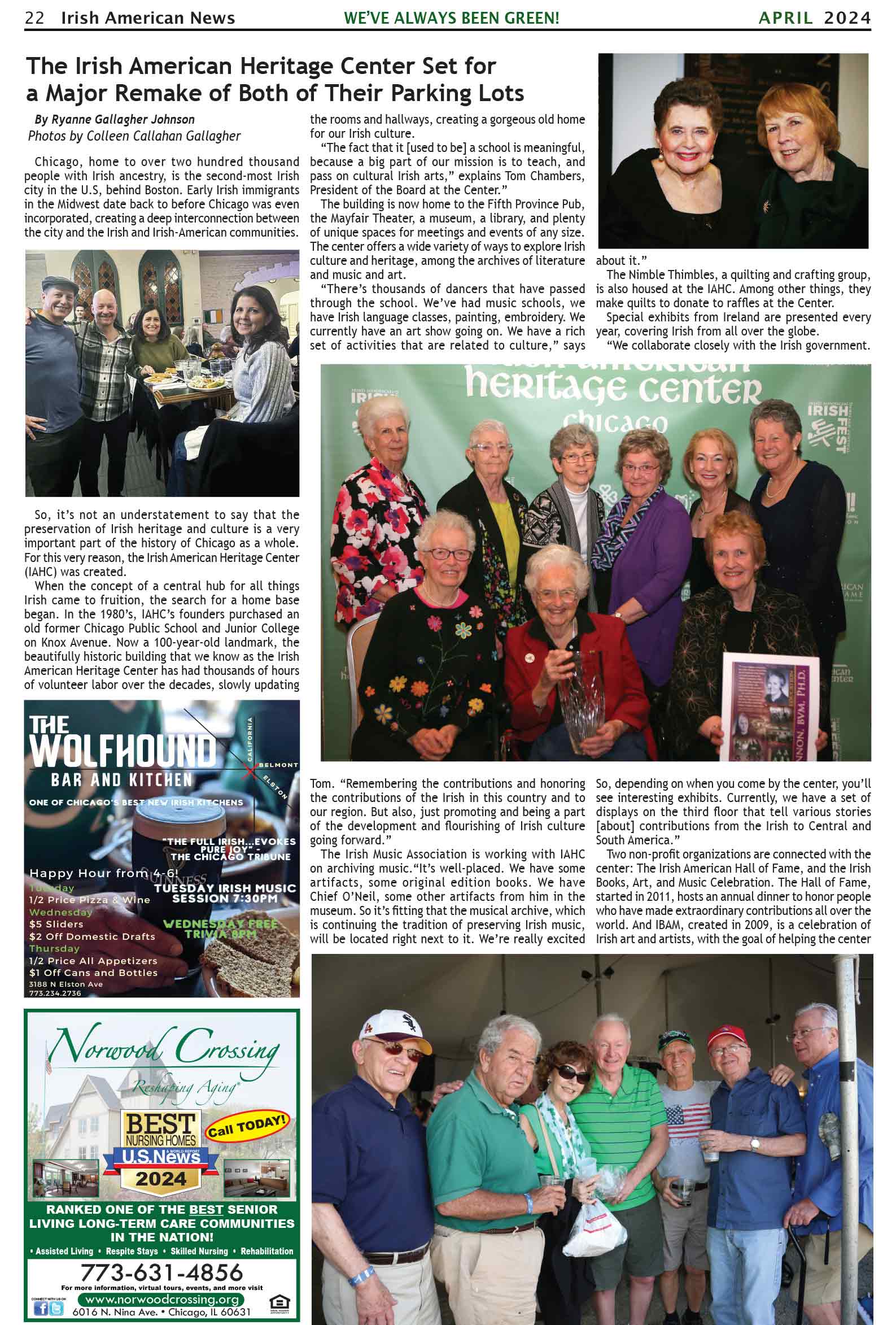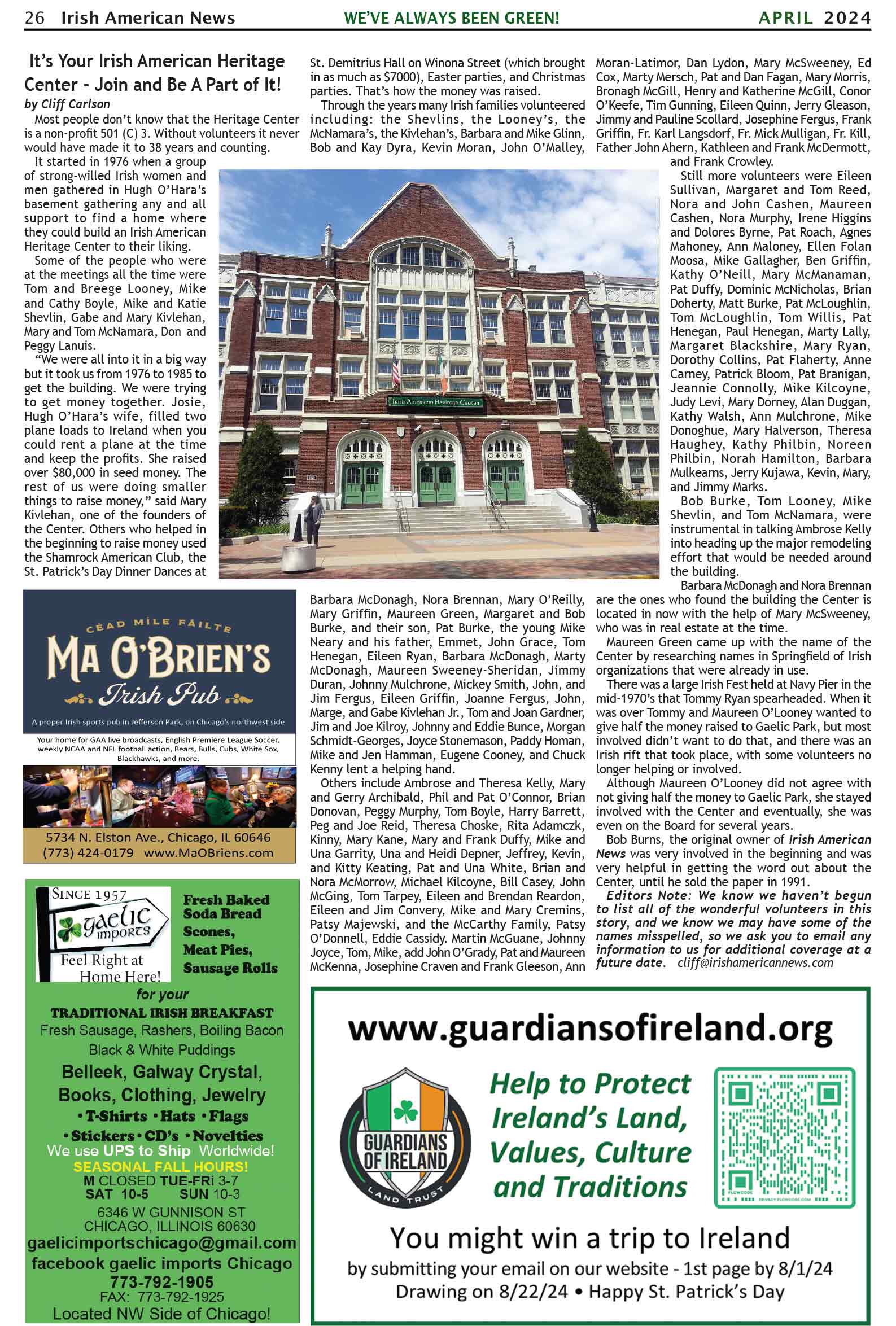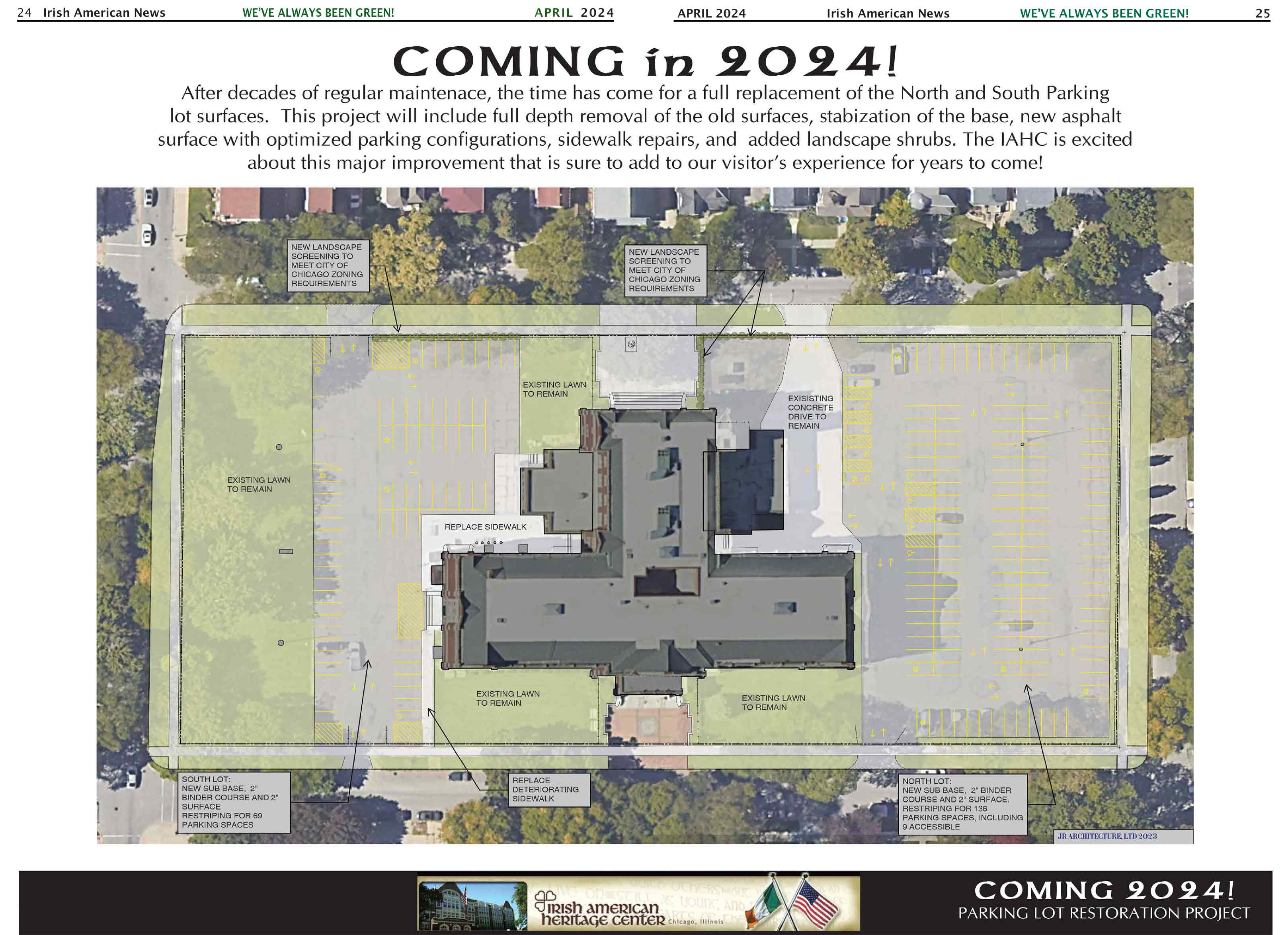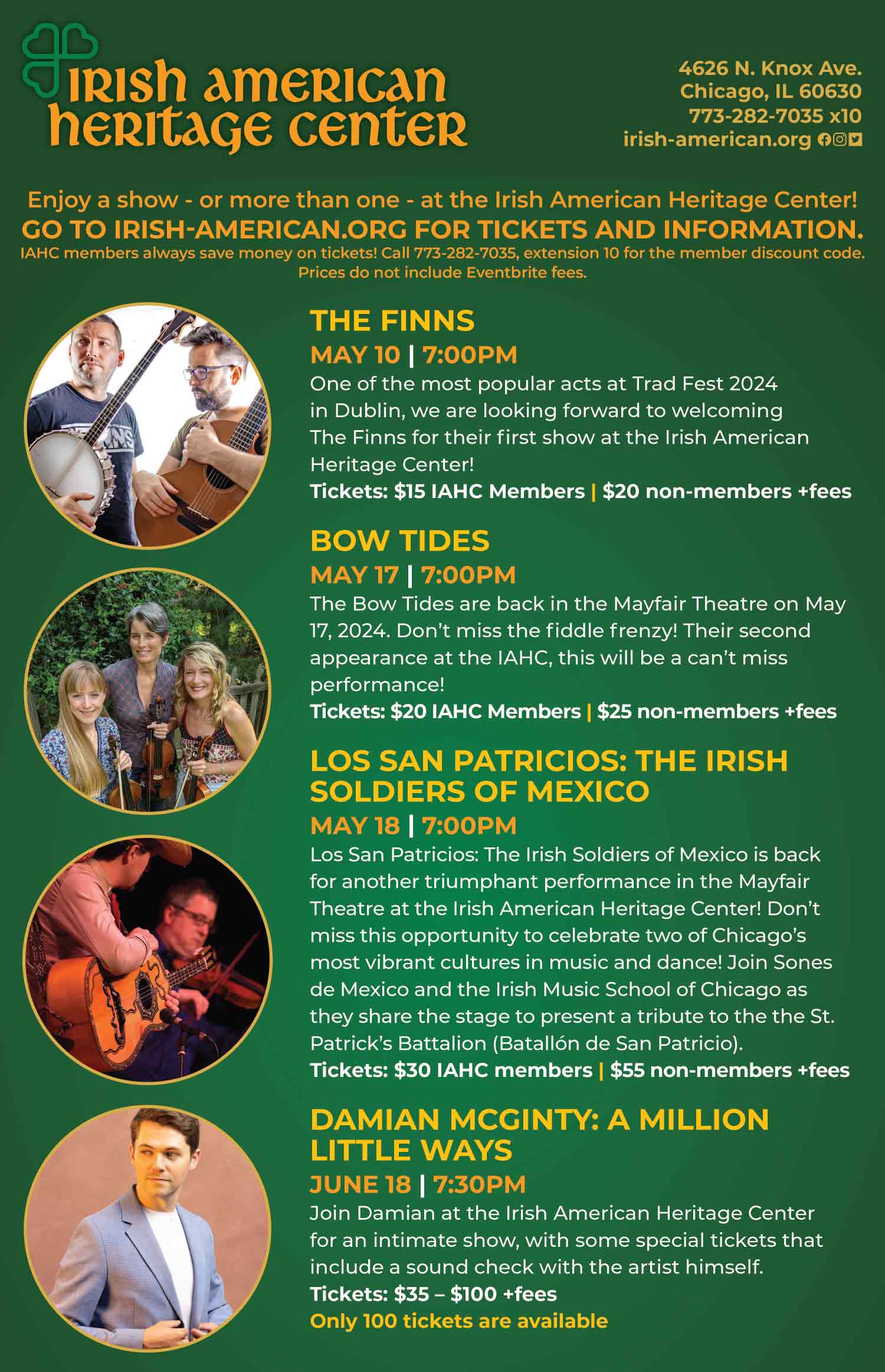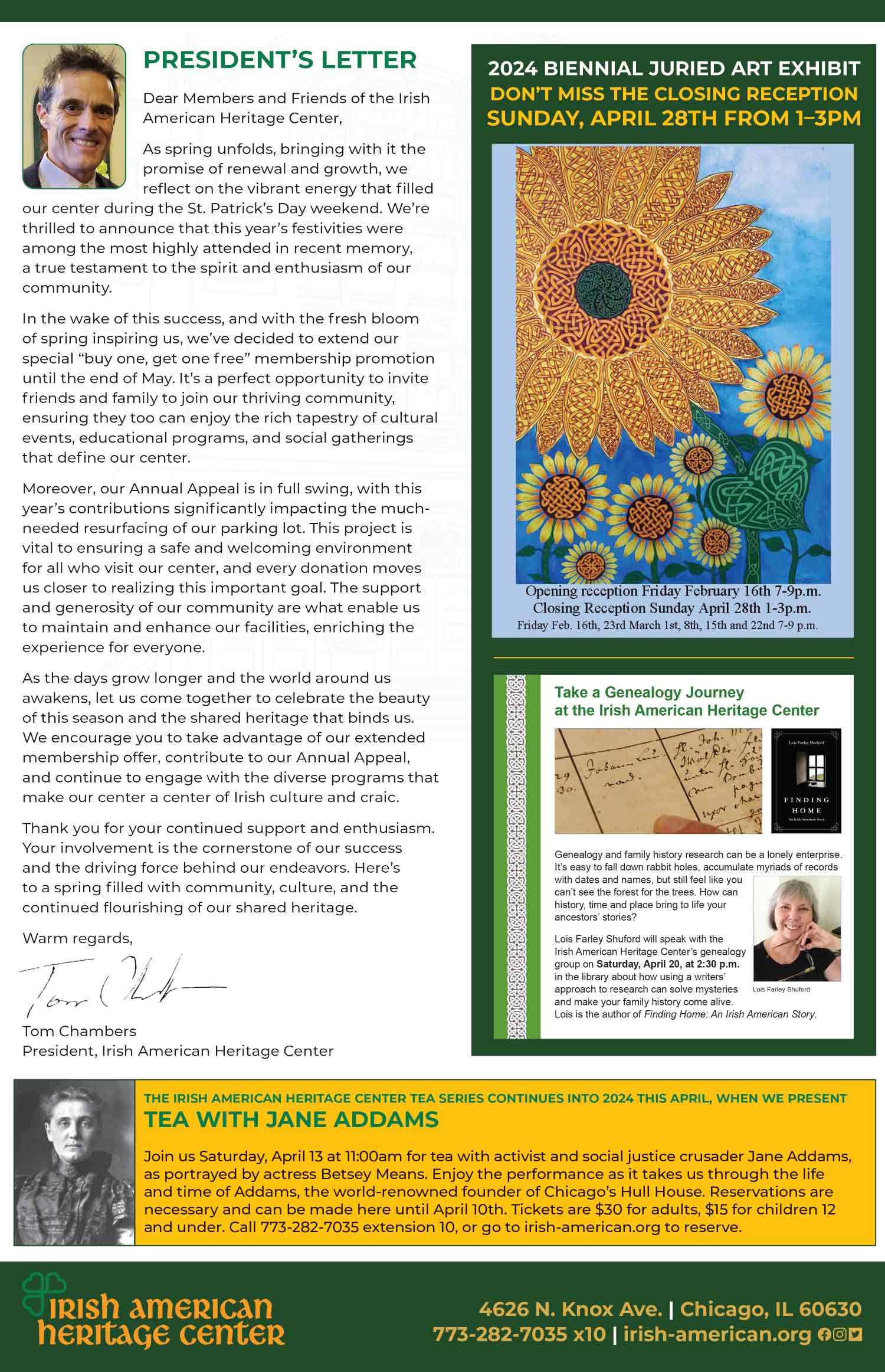By Ryanne Gallagher Johnson
Photos by Colleen Callahan Gallagher
all pages from the article are below stories:
Chicago, home to over two hundred thousand people with Irish ancestry, is the second-most Irish city in the U.S, behind Boston. Early Irish immigrants in the Midwest date back to before Chicago was even incorporated, creating a deep interconnection between the city and the Irish and Irish-American communities.
So, it’s not an understatement to say that the preservation of Irish heritage and culture is a very important part of the history of Chicago as a whole. For this very reason, the Irish American Heritage Center (IAHC) was created.
When the concept of a central hub for all things Irish came to fruition, the search for a home base began.
In the 1980’s, IAHC’s founders purchased an old former Chicago Public School and Junior College on Knox Avenue. Now a 100-year-old landmark, the beautifully historic building that we know as the Irish American Heritage Center has had thousands of hours of volunteer labor over the decades, slowly updating the rooms and hallways, creating a gorgeous old home for our Irish culture. “The fact that it [used to be] a school is meaningful, because a big part of our mission is to teach, and pass on cultural Irish arts,” explains Tom Chambers, President of the Board at the Center.”
The building is now home to the Fifth Province Pub, the Mayfair Theater, a museum, a library, and plenty of unique spaces for meetings and events of any size. The center offers a wide variety of ways to explore Irish culture and heritage, among the archives of literature and music and art.
“There’s thousands of dancers that have passed through the school. We’ve had music schools, we have Irish language classes, painting, embroidery. We currently have an art show going on. We have a rich set of activities that are related to culture,” says Tom. “Remembering the contributions and honoring the contributions of the Irish in this country and to our region. But also, just promoting and being a part of the development and flourishing of Irish culture going forward.” The Irish Music Association is working with IAHC on archiving music.“It’s well-placed. We have some artifacts, some original edition books. We have Chief O’Neil, some other artifacts from him in the museum. So it’s fitting that the musical archive, which is continuing the tradition of preserving Irish music, will be located right next to it. We’re really excited about it.”
The Nimble Thimbles, a quilting and crafting group, is also housed at the IAHC. Among other things, they make quilts to donate to raffles at the Center.
Special exhibits from Ireland are presented every year, covering Irish from all over the globe. “We collaborate closely with the Irish government. So, depending on when you come by the center, you’ll see interesting exhibits. Currently, we have a set of displays on the third floor that tell various stories [about] contributions from the Irish to Central and South America.” Two non-profit organizations are connected with the center: The Irish American Hall of Fame, and the Irish Books, Art, and Music Celebration. The Hall of Fame, started in 2011, hosts an annual dinner to honor people who have made extraordinary contributions all over the world. And IBAM, created in 2009, is a celebration of Irish art and artists, with the goal of helping the center and awarding people in the culture of everything Irish.
For all of its work and teaching and offerings to the Irish community, the IAHC runs on donations and volunteer time. They were fortunate to make it through the pandemic, and have a running list of needs for the building that they’ve managed to keep up with through the ebbs and flows of the economy, but the fact remains that there is always a need for more. “We’ve got two focuses over the last few months, and through the spring,” says Tom. “We want to increase our memberships, so we’re in the midst of a membership drive. [And] we are raising funds so that we can redo our parking lot. The Heritage Center building is 100 years old this year. It’s got a lot of needs, but we decided to move forward this year with a major refurbishing the parking lot, which needs repairs badly.”
Membership was steady during the pandemic but not growing, so the push for more members is important. Rooms, classrooms, and the theater are available for rent for various events and gatherings. Portable bars and food service are available for parties. Classes in dance, art, Irish language, and music are offered through the center. Volunteers are also needed, in a wide variety of skills and interests. “We want this place to continue to be vibrant, and it needs people to do that. . . If you have something you’d like to do, or if you have a skill, we’d love to have you.” The Irish American Heritage Center is a 501(c)(3) tax-deductible organization. You can find information on the center, including a calendar of classes, list of spaces for rent, and links for donations and memberships, on their website, irish-american.org.
It’s Your Irish American Heritage Center - Join and Be A Part of It!
by Cliff Carlson
Most people don’t know that the Heritage Center is a non-profit 501 (C) 3. Without volunteers it never would have made it to 38 years and counting. It started in 1976 when a group of strong-willed Irish women and men gathered in Hugh O’Hara’s basement gathering any and all support to find a home where they could build an Irish American Heritage Center to their liking. Some of the people who were at the meetings all the time were Tom and Breege Looney, Mike and Cathy Boyle, Mike and Katie Shevlin, Gabe and Mary Kivlehan, Mary and Tom McNamara, Don and Peggy Lanuis. “We were all into it in a big way but it took us from 1976 to 1985 to get the building. We were trying to get money together. Josie, Hugh O’Hara’s wife, filled two plane loads to Ireland when you could rent a plane at the time and keep the profits. She raised over $80,000 in seed money. The rest of us were doing smaller things to raise money,” said Mary Kivlehan, one of the founders of the Center. Others who helped in the beginning to raise money used the Shamrock American Club, the St. Patrick’s Day Dinner Dances at St. Demitrius Hall on Winona Street (which brought in as much as $7000), Easter parties, and Christmas parties. That’s how the money was raised.
Through the years many Irish families volunteered including: the Shevlins, the Looney’s, the McNamara’s, the Kivlehan’s, Barbara and Mike Glinn, Bob and Kay Dyra, Kevin Moran, John O’Malley, Barbara McDonagh, Nora Brennan, Mary O’Reilly, Mary Griffin, Maureen Green, Margaret and Bob Burke, and their son, Pat Burke, the young Mike Neary and his father, Emmet, John Grace, Tom Henegan, Eileen Ryan, Barbara McDonagh, Marty McDonagh, Maureen Sweeney-Sheridan, Jimmy Duran, Johnny Mulchrone, Mickey Smith, John, and Jim Fergus, Eileen Griffin, Joanne Fergus, John, Marge, and Gabe Kivlehan Jr., Tom and Joan Gardner, Jim and Joe Kilroy, Johnny and Eddie Bunce, Morgan Schmidt-Georges, Joyce Stonemason, Paddy Homan, Mike and Jen Hamman, Eugene Cooney, and Chuck Kenny lent a helping hand. Others include Ambrose and Theresa Kelly, Mary and Gerry Archibald, Phil and Pat O’Connor, Brian Donovan, Peggy Murphy, Tom Boyle, Harry Barrett, Peg and Joe Reid, Theresa Choske, Rita Adamczk, Kinny, Mary Kane, Mary and Frank Duffy, Mike and Una Garrity, Una and Heidi Depner, Jeffrey, Kevin, and Kitty Keating, Pat and Una White, Brian and Nora McMorrow, Michael Kilcoyne, Bill Casey, John McGing, Tom Tarpey, Eileen and Brendan Reardon, Eileen and Jim Convery, Mike and Mary Cremins, Patsy Majewski, and the McCarthy Family, Patsy O’Donnell, Eddie Cassidy. Martin McGuane, Johnny Joyce, Tom, Mike, add John O’Grady, Pat and Maureen McKenna, Josephine Craven and Frank Gleeson, Ann Moran-Latimor, Dan Lydon, Mary McSweeney, Ed Cox, Marty Mersch, Pat and Dan Fagan, Mary Morris, Bronagh McGill, Henry and Katherine McGill, Conor O’Keefe, Tim Gunning, Eileen Quinn, Jerry Gleason, Jimmy and Pauline Scollard, Josephine Fergus, Frank Griffin, Fr. Karl Langsdorf, Fr. Mick Mulligan, Fr. Kill, Father John Ahern, Kathleen and Frank McDermott, and Frank Crowley.
Still more volunteers were Eileen Sullivan, Margaret and Tom Reed, Nora and John Cashen, Maureen Cashen, Nora Murphy, Irene Higgins and Dolores Byrne, Pat Roach, Agnes Mahoney, Ann Maloney, Ellen Folan Moosa, Mike Gallagher, Ben Griffin, Kathy O’Neill, Mary McManaman, Pat Duffy, Dominic McNicholas, Brian Doherty, Matt Burke, Pat McLoughlin, Tom McLoughlin, Tom Willis, Pat Henegan, Paul Henegan, Marty Lally, Margaret Blackshire, Mary Ryan, Dorothy Collins, Pat Flaherty, Anne Carney, Patrick Bloom, Pat Branigan, Jeannie Connolly, Mike Kilcoyne, Judy Levi, Mary Dorney, Alan Duggan, Kathy Walsh, Ann Mulchrone, Mike Donoghue, Mary Halverson, Theresa Haughey, Kathy Philbin, Noreen Philbin, Norah Hamilton, Barbara Mulkearns, Jerry Kujawa, Kevin, Mary, and Jimmy Marks. Bob Burke, Tom Looney, Mike Shevlin, and Tom McNamara, were instrumental in talking Ambrose Kelly into heading up the major remodeling effort that would be needed around the building. Barbara McDonagh and Nora Brennan are the ones who found the building the Center is located in now with the help of Mary McSweeney, who was in real estate at the time.
Maureen Green came up with the name of the Center by researching names in Springfield of Irish organizations that were already in use. There was a large Irish Fest held at Navy Pier in the mid-1970’s that Tommy Ryan spearheaded. When it was over Tommy and Maureen O’Looney wanted to give half the money raised to Gaelic Park, but most involved didn’t want to do that, and there was an Irish rift that took place, with some volunteers no longer helping or involved.
Although Maureen O’Looney did not agree with not giving half the money to Gaelic Park, she stayed involved with the Center and eventually, she was even on the Board for several years. Bob Burns, the original owner/publisher of Irish American News was very involved in the beginning and was very helpful in getting the word out about the Center, until he sold the paper in 1991.
Editors Note: We know we haven’t begun to list all of the wonderful volunteers in this story, and we know we may have some of the names misspelled, so we ask you to email any information to us for additional coverage at a future date.This email address is being protected from spambots. You need JavaScript enabled to view it.
Sidebar
Magazine menu

 Irish American News
News for the Irish in America
Irish American News
News for the Irish in America
01
Wed, May


